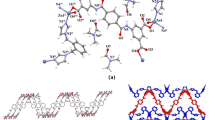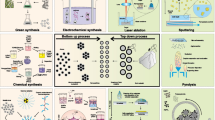Abstract
The post-functionalization of gold nanoclusters with organic molecules into organic–inorganic hybrid functional materials is an efficient approach to develop multifunctional materials. By introducing 1-pyrenamine and 3-aminofluoranthene into [O(AuPPh3)3][BF4] with a covalent bond, two novel organoimido functionalized trinuclear gold nanoclusters [C16H9N(AuPPh3)3][BF4] (Au3–P) and [C6H4–C10H5N(AuPPh3)3][BF4] (Au3–F) have been successfully obtained. Their structures have been determined by electrospray ionization mass spectroscopy (ESI–MS) and single-crystal X-ray diffraction (SC-XRD), and the photoluminescence properties have been investigated from both experimental and theoretical aspects. It is found that the lowest-energy electronic transitions in the ultraviolet–visible (UV–Vis) absorption spectra of Au3–P (403 nm) and Au3–F (425 nm) exhibit a slight bathochromic shift compared to the corresponding transitions in the spectra of 1-pyrenamine and 3-aminofluoranthene, respectively. In addition, the dichloromethane solutions of Au3–P and Au3–F complexes clearly display blue and yellowish-green fluorescence, respectively. These results will help to design and prepare organic–inorganic nanocluster hybrid luminescent materials for potential applications in (bio)sensors, bioimaging and optoelectronic devices.






Similar content being viewed by others
References
Yang Z, Mao Z, Xie Z, Zhang Y, Liu S, Zhao J, Xu J, Chi Z, Aldred MP. Recent advances in organic thermally activated delayed fluorescence materials. Chem Soc Rev. 2017;46(3):915.
Liang F, Liu JX. Photoluminescence properties of hexagonal indium tin oxide nanopowders prepared by solvothermal method. Rare Met. 2018;37(1):47.
Choung KS, Marroquin K, Teets TS. Cyclometalated iridium-BODIPY ratiometric O2 sensors. Chem Sci. 2019;10(19):5124.
Wang JC, Luo HS, Zhang MH, Zu XH, Zhang J, Gu YX, Yi GB. Design and fabrication of a new fluorescence enhancement system of silver nanoparticles-decorated aligned silver nanowires. Rare Met. 2019;38(12):1178.
Fan L, Wang X, Ge J, Li F, Zhang C, Lin B, Shuang S, Dong C. A Golgi-targeted off-on fluorescent probe for real-time monitoring of pH changes in vivo. Chem Commun. 2019;55(47):6685.
Luo X, Xue B, Feng G, Zhang J, Lin B, Zeng P, Li H, Yi H, Zhang XL, Zhu H, Nie Z. Lighting up the native viral RNA genome with a fluorogenic probe for the live-cell visualization of virus infection. J Am Chem Soc. 2019;141(13):5182.
Fu Y, Han HH, Zhang J, He XP, Feringa BL, Tian H. Photocontrolled fluorescence “double-check” bioimaging enabled by a glycoprobe-protein hybrid. J Am Chem Soc. 2018;140(28):8671.
Gao JF, Yang JH, Zhang XY, Zhao J, Liu XW, Shi BF. Synthesis and fluorescence properties of CdTe:Eu3+ nanocrystals and core-shell SiO2-coated CdTe:Eu3+ nanospheres. Rare Met. 2019;38(10):989.
Gui R, Jin H, Bu X, Fu Y, Wang Z, Liu Q. Recent advances in dual-emission ratiometric fluorescence probes for chemo/biosensing and bioimaging of biomarkers. Coordin Chem Rev. 2019;383:82.
Gao RW, Teraphongphom NT, van den Berg NS, Martin BA, Oberhelman NJ, Divi V, Kaplan MJ, Hong SS, Lu G, Ertsey R, Tummers WSFJ, Gomez AJ, Holsinger FC, Kong CS, Colevas AD, Warram JM, Rosenthal EL. Determination of tumor margins with surgical specimen mapping using near-infrared fluorescence. Cancer Res. 2018;78(17):5144.
Huang D, Lin S, Wang Q, Zhang Y, Li C, Ji R, Wang M, Chen G, Wang Q. An NIR-II fluorescence/dual bioluminescence multiplexed imaging for in vivo visualizing the location, survival, and differentiation of transplanted stem cells. Adv Funct Mater. 2019;29(2):1806546.
Rossdam C, Konze SA, Oberbeck A, Rapp E, Gerardy-Schahn R, Itzstein M, Buettner FFR. Approach for profiling of glycosphingolipid glycosylation by multiplexed capillary gel electrophoresis coupled to laser-induced fluorescence detection to identify cell-surface markers of human pluripotent stem cells and derived cardiomyocytes. Anal Chem. 2019;91(10):6413.
Wong MY, Zysman-Colman E. Purely organic thermally activated delayed fluorescence materials for organic light-emitting diodes. Adv Mater. 2017;29(22):1605444.
Miao Q, Pu K. Organic semiconducting agents for deep-tissue molecular imaging: second near-infrared fluorescence, self-luminescence, and photoacoustics. Adv Mater. 2018;30(49):1801778.
Chinen AB, Guan CM, Ferrer JR, Barnaby SN, Merkel TJ, Mirkin CA. Nanoparticle probes for the detection of cancer biomarkers, cells, and tissues by fluorescence. Chem Rev. 2015;115(19):10530.
Li J, Yim D, Jang WD, Yoon J. Recent progress in the design and applications of fluorescence probes containing crown ethers. Chem Soc Rev. 2017;46(9):2437.
Yue GZ, Su S, Li N, Shuai MB, Lai XC, Astruc D, Zhao PX. Gold nanoparticles as sensors in the colorimetric and fluorescence detection of chemical warfare agents. Coordin Chem Rev. 2016;311:75.
Saha ML, Yan X, Stang PJ. Photophysical properties of organoplatinum(II) compounds and derived self-assembled metallacycles and metallacages: fluorescence and its applications. Acc Chem Res. 2016;49(11):2527.
Ravotto L, Ceroni P. Aggregation induced phosphorescence of metal complexes: from principles to applications. Coordin Chem Rev. 2017;346:62.
Li D, Song J, Yin P, Simotwo S, Bassler AJ, Aung YY, Roberts JE, Hardcastle KI, Hill CL, Liu T. Inorganic-organic hybrid vesicles with counterion- and pH-controlled fluorescent properties. J Am Chem Soc. 2011;133(35):14010.
Parrot A, Bernard A, Jacquart A, Serapian SA, Bo C, Derat E, Oms O, Dolbecq A, Proust A, Métivier R, Mialane P, Izzet G. Photochromism and dual-color fluorescence in a polyoxometalate-benzospiropyran molecular switch. Angew Chem Int Ed. 2017;56(17):4872.
Higaki T, Li Q, Zhou M, Zhao S, Li Y, Li S, Jin R. Toward the tailoring chemistry of metal nanoclusters for enhancing functionalities. Acc Chem Res. 2018;51(11):2764.
Lei Z, Wan XK, Yuan SF, Wang JQ, Wang QM. Alkynyl-protected gold and gold-silver nanoclusters. Dalton Trans. 2017;46(11):3427.
Desireddy A, Conn BE, Guo J, Yoon B, Barnett RN, Monahan BM, Kirschbaum K, Griffith WP, Whetten RL, Landman U, Bigioni TP. Ultrastable silver nanoparticles. Nature. 2013;501(7467):399.
Yang H, Wang Y, Huang H, Gell L, Lehtovaara L, Malola S, Häkkinen H, Zheng N. All-thiol-stabilized Ag44 and Au12Ag32 nanoparticles with single-crystal structures. Nat Commun. 2013;4:2422.
Zhou K, Qin C, Wang XL, Shao KZ, Yan LK, Su ZM. Self-assembly of an all-thiol-stabilized Ag28S23 high-nuclearity luminescent nanocluster with a “crab-like” shape. Dalton Trans. 2014;43(28):10695.
Lin YM, Guan ZJ, Liu KG, Jiang ZG, Wang QM. Assembly of silver alkynyl compounds with various nuclearities. Dalton Trans. 2015;44(5):2439.
Yang H, Wang Y, Chen X, Zhao X, Gu L, Huang H, Yan J, Xu C, Li G, Wu J, Edwards AJ, Dittrich B, Tang Z, Wang D, Lehtovaara L, Häkkinen H, Zheng N. Plasmonic twinned silver nanoparticles with molecular precision. Nat Commun. 2016;7:12809.
Femoni C, Iapalucci MC, Longoni G, Zacchini S, Zarra S. Icosahedral Pt-centered Pt13 and Pt19 carbonyl clusters decorated by [Cd5(μ–Br)5Br5–x(solvent)x]x+ rings reminiscent of the decoration of Au–Fe–CO and Au-thiolate nanoclusters: a unifying approach to their electron counts. J Am Chem Soc. 2011;133(8):2406.
Mednikov EG, Dahl LF. Ion exchange of protons by coinage metals to give gold and silver encapsulation within a pseudo-D2d distorted face-capped Pd14 cubic kernel: [(µ14–M)Pd22(CO)20(PEt3)8]+ (M = Au, Ag). Angew Chem Int Ed. 2013;52(30):7813.
Teramoto M, Iwata K, Yamaura H, Kurashima K, Miyazawa K, Kurashige Y, Yamamoto K, Murahashi T. Three-dimensional sandwich nanocubes composed of 13-atom palladium core and hexakis-carbocycle shell. J Am Chem Soc. 2018;140(40):12682.
Dolzhnikov DS, Iapalucci MC, Longoni G, Tiozzo C, Zacchini S, Femoni C. New high-nuclearity carbonyl and carbonyl-substituted rhodium clusters and their relationships with polyicosahedral carbonyl-substituted palladium- and gold-thiolates. Inorg Chem. 2012;51(21):11214.
Adams RD, Zhang Q, Yang X. Two-dimensional bimetallic carbonyl cluster complexes with new properties and reactivities. J Am Chem Soc. 2011;133(40):15950.
Song Y, Fu F, Zhang J, Chai J, Kang X, Li P, Li S, Zhou H, Zhu M. The magic Au60 nanocluster: a new cluster-assembled material with five Au13 building blocks. Angew Chem Int Ed. 2015;54(29):8430.
Zeng C, Chen Y, Kirschbaum K, Lambright KJ, Jin R. Emergence of hierarchical structural complexities in nanoparticles and their assembly. Science. 2016;354(6319):1580.
Yao LY, Lee TKM, Yam VWW. Thermodynamic-driven self-assembly: heterochiral self-sorting and structural reconfiguration in gold(I)-sulfido cluster system. J Am Chem Soc. 2016;138(23):7260.
Yan N, Xia N, Liao L, Zhu M, Jin F, Jin R, Wu Z. Unraveling the long-pursued Au144 structure by X-ray crystallography. Sci Adv. 2018;4(10):eaat7259.
Wang S, Li Q, Kang X, Zhu M. Customizing the structure, composition, and properties of alloy nanoclusters by metal exchange. Acc Chem Res. 2018;51(11):2784.
Zhou M, Higaki T, Hu G, Sfeir MY, Chen Y, Jiang D, Jin R. Three-orders-of-magnitude variation of carrier lifetimes with crystal phase of gold nanoclusters. Science. 2019;364(6437):279.
Schmidbaur H, Kolb A, Bissinger P. Synthesis and structure of trinuclear and novel tetranuclear gold(I) complexes derived from 8-aminoquinoline. Inorg Chem. 1992;31(21):4370.
Xia A, James AJ, Sharp PR. Gold(I)-mediated rearrangement of 1,2-diphenylhydrazine to semidines. Organometallics. 1999;18(3):451.
Flint BW, Yang Y, Sharp PR. Gold(I) heteroatom-substituted imido complexes. Amino nitrene loss from [(LAu)3(μ–NNR2)]+. Inorg Chem. 2000;39(3):602.
He X, Wang Y, Jiang H, Zhao L. Structurally well-defined sigmoidal gold clusters: probing the correlation between metal atom arrangement and chiroptical response. J Am Chem Soc. 2016;138(17):5634.
Guo P, Yang B, Zhang L, Zhao L. Temperature dependent chiroptical response of sigmoidal gold clusters: probing the stability of chiral metal clusters. Chem Sci. 2018;9(25):5614.
Acknowledgments
This work was financially supported by the foundation of Key Laboratory of Ethnomedicine (Minzu University of China), Ministry of Education (No. KLEM-ZZ201804), the Young Teachers’ Scientific Research Ability Promotion Program of Minzu University of China (No. 2018QNPY57) and Beijing Municipal Natural Science Foundation (No. 2154049).
Author information
Authors and Affiliations
Corresponding authors
Electronic supplementary material
Below is the link to the electronic supplementary material.
Rights and permissions
About this article
Cite this article
Lv, CL., Yang, CH., Liu, LY. et al. Organoimido functionalized trinuclear gold(I) clusters with fluorescent chromophore. Rare Met. 40, 1437–1442 (2021). https://doi.org/10.1007/s12598-020-01562-7
Received:
Revised:
Accepted:
Published:
Issue Date:
DOI: https://doi.org/10.1007/s12598-020-01562-7




